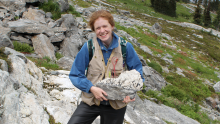An unassuming mineral hidden away in rock samples collected almost 30 years ago has been named after a professor of Earth, Ocean and Atmospheric Sciences at the University of British Columbia.
Groatite, a new species of phosphate mineral, was named after Lee Groat, a professor of mineralogy at the university.
Details of the discovery and properties of the mineral were outlined in the most recent issue of The Canadian Mineralogist by a team led by researchers from the University of Manitoba.
Frank Hawthorne, the principal investigator on the paper, named the mineral after Groat for his extensive contributions to pegmatite mineralogy.
“I was surprised and honoured,” says Groat. “I did my PhD under Frank at the University of Manitoba. When he approached me at the 2008 Geological Association of Canada meeting in Quebec City to ask my permission to name a mineral after me, I was stunned.”
“I want to say thank you to everyone who was involved, because I know how much work it is.”
When a new mineral is discovered, researchers must identify its physical properties to prove that it is unique. Density, chemistry, colour, hardness, crystal structure and other traits exhibited by the specimen are examined to determine if the sample is unique.
About 60 new mineral species are discovered every year.
In the case of groatite, it was years before the research team realized there was a new mineral in the samples that they had collected from the Tanco pegmatite at Bernic Lake, Manitoba 1980. Found in a phosphate-carbon mass in a spodumen-rich boulder, the newly discovered mineral appears as sprays of colourless to pale yellow crystals on whitlockite, another phosphate mineral, allowing it to go undetected. The sample turned out to be a new ‘phase’ of a phosphate mineral from the alluaudite group. An application was then submitted to the Commission on New Mineral Names of the International Mineralogical Association (IMA), where it was assessed and voted on by the commission’s delegates.
Of the approximately 4,350 known minerals, around 45 per cent are named after people, of which 102 are Canadians (2003 figures). Other UBC faculty who have been honoured in this way are: Henry Cecil Gunning (1901-1991), Robert Mitchell Thompson (1918-1967), and John Arthur Gower (1921-1972).
The IMA also judges the acceptability of the proposed name--often a person, locality, institution, chemical composition or distinctive property such as colour or shape. Groat received his Bachelor of Science in Geology from Queen’s University in 1982 before pursuing his Master’s and PhD at the University of Manitoba. He came to UBC in 1989 after completing his NATO Postdoctoral Fellowship at Cambridge University. Groat was an associate editor for Canadian Mineralogist and American Mineralogist throughout the 1990s, and editor of American Mineralogist from 2001 to 2006. He is also an elected Fellow of the Mineralogical Society of America. Currently, Groat is the director of UBC’s Integrated Sciences program.
Musqueam First Nation land acknowledegement
We honour xwməθkwəy̓ əm (Musqueam) on whose ancestral, unceded territory UBC Vancouver is situated. UBC Science is committed to building meaningful relationships with Indigenous peoples so we can advance Reconciliation and ensure traditional ways of knowing enrich our teaching and research.
Learn more: Musqueam First Nation
Faculty of Science
Office of the Dean, Earth Sciences Building2178–2207 Main Mall
Vancouver, BC Canada
V6T 1Z4

